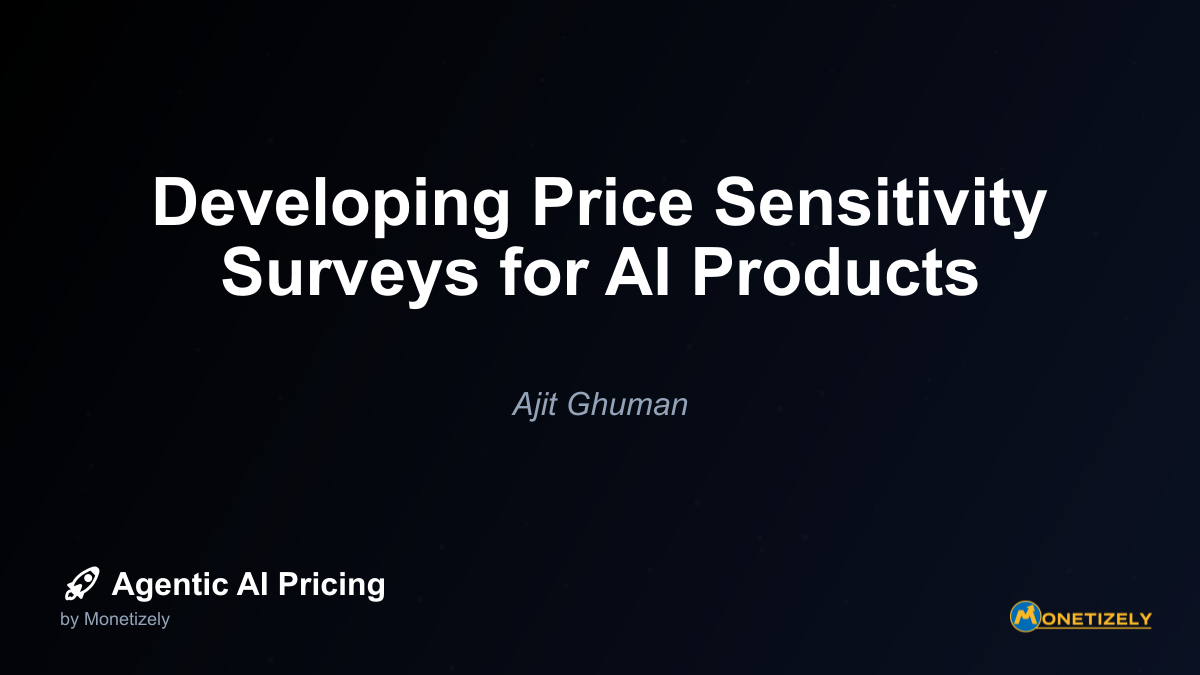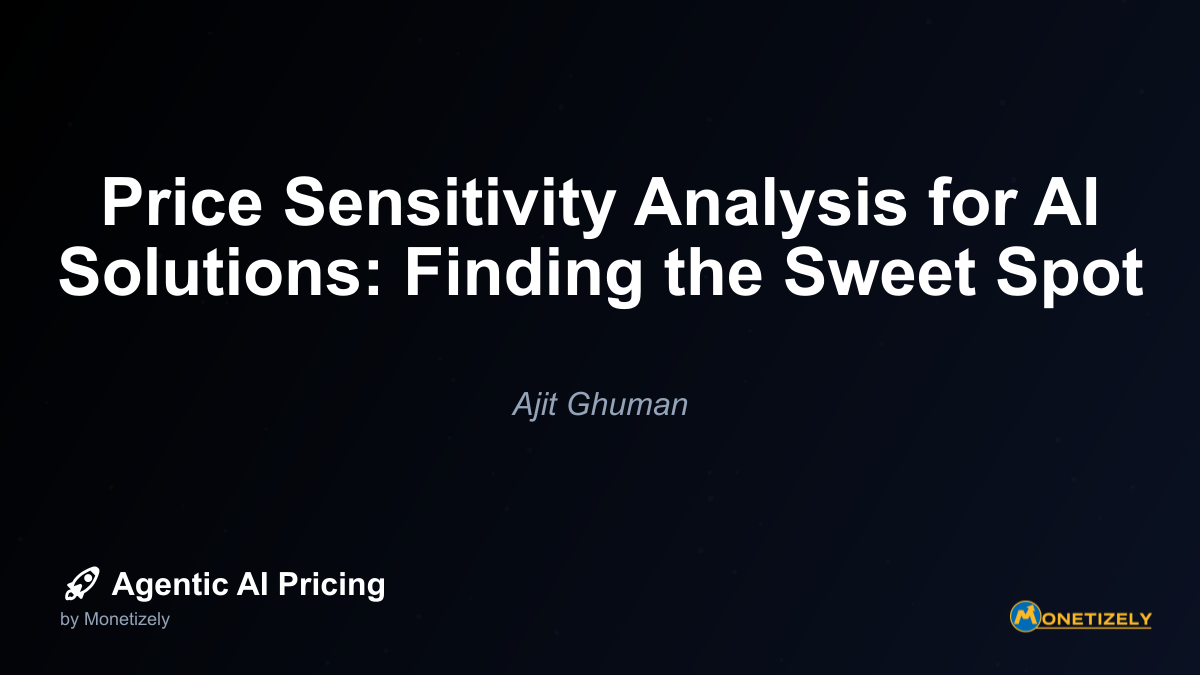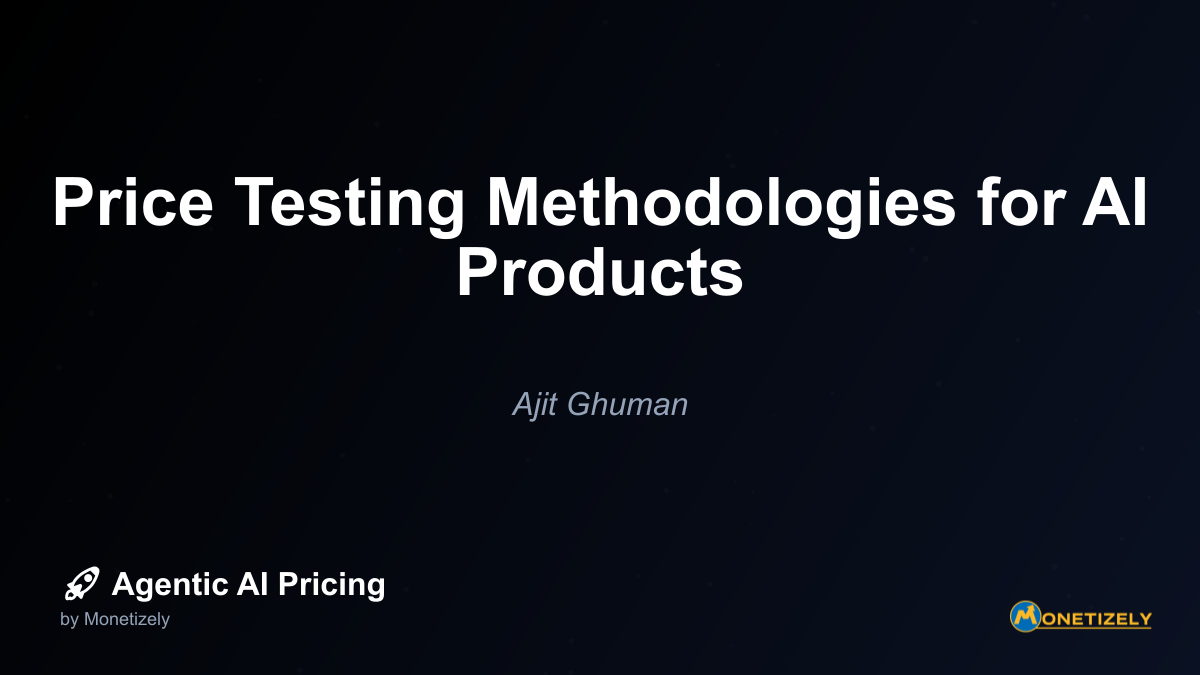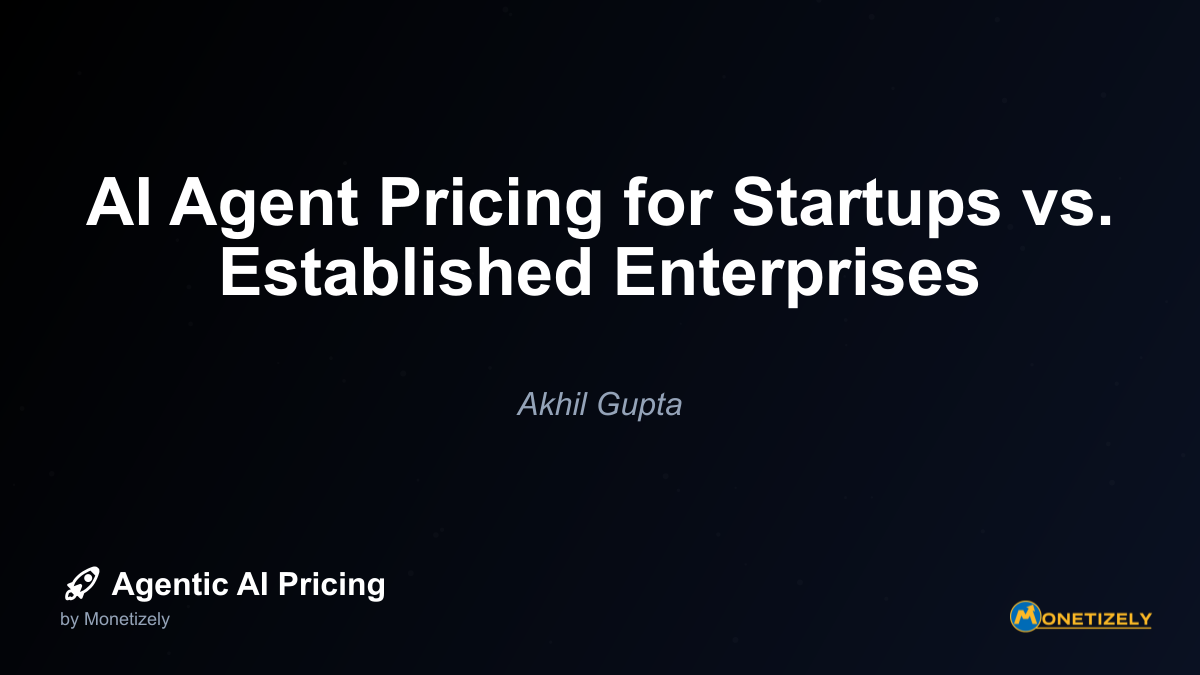· Ajit Ghuman · Strategy · 10 min read
Developing Price Sensitivity Surveys for AI Products
AI and SaaS Pricing Masterclass
Learn the art of strategic pricing directly from industry experts. Our comprehensive course provides frameworks and methodologies for optimizing your pricing strategy in the evolving AI landscape. Earn a professional certification that can be imported directly to your LinkedIn profile.

The Unique Challenges of AI Product Price Testing
Pricing AI products effectively requires navigating several distinct challenges:
Value perception gaps: Customers often struggle to accurately value AI capabilities they haven’t experienced before.
Varying impact across segments: AI products may deliver dramatically different value to different customer segments.
Rapid innovation cycles: The competitive landscape for AI products evolves quickly, potentially shifting price sensitivity over short periods.
Multi-dimensional value creation: AI products often create value across multiple dimensions simultaneously (time savings, error reduction, insight generation), making it difficult for customers to quantify total value.
Reference price scarcity: Without established market prices for novel capabilities, customers lack reference points for judging fairness.
These challenges make traditional pricing approaches insufficient. A strategic approach to price sensitivity research becomes essential for AI product success.
Designing Effective Price Sensitivity Surveys for AI Products
Step 1: Define Your Research Objectives
Before creating your survey, clearly define what you aim to discover:
- Are you primarily testing willingness to pay for a specific feature?
- Do you need to understand price sensitivity differences across market segments?
- Are you evaluating different pricing models (subscription vs. usage-based) for the same capabilities?
- Do you need to understand how price sensitivity varies with different value messaging?
Your research objectives will determine your survey design, sample selection, and analysis approach. For AI products specifically, consider objectives like:
- Understanding how technical sophistication correlates with willingness to pay
- Identifying which AI capabilities drive the most perceived value
- Determining how much customers would pay for improved accuracy or performance
Step 2: Select the Right Survey Methodology
Several established methodologies exist for price sensitivity research, each with strengths and limitations for AI products:
Van Westendorp Price Sensitivity Meter (PSM)
This classic approach asks four key questions:
- At what price would this product be so expensive you wouldn’t consider buying it? (Too expensive)
- At what price would this product start to seem expensive, but you’d still consider it? (Expensive/High)
- At what price would this product seem like a bargain? (Inexpensive/Good value)
- At what price would this product be so inexpensive that you’d question its quality? (Too cheap)
Advantages for AI products: Simple to implement and provides clear price range boundaries.
Limitations for AI products: Doesn’t account for competitive alternatives or feature variations. May be challenging for respondents when evaluating novel capabilities with no reference points.
Gabor-Granger Method
This approach presents a specific price point and asks respondents if they would purchase at that price. Based on their response, the price is adjusted up or down until finding the maximum acceptable price.
Advantages for AI products: Helps identify price thresholds and provides clear willingness-to-pay data.
Limitations for AI products: Can be influenced by the initial price shown (anchoring bias), which is particularly problematic for novel AI capabilities.
Conjoint Analysis
This sophisticated approach asks respondents to choose between product configurations with different features and price points, allowing researchers to determine the relative importance of features and price sensitivity.
Advantages for AI products: Excellent for understanding feature value trade-offs and price sensitivity simultaneously, which is crucial for AI products with multiple capabilities.
Limitations for AI products: More complex to design and analyze. Requires careful selection of attributes and levels to avoid overwhelming respondents.
Monadic Price Testing
In this approach, different respondent groups see different price points for the same product, allowing comparison of purchase intent across prices.
Advantages for AI products: Minimizes anchoring bias and simulates real-world purchase decisions.
Limitations for AI products: Requires larger sample sizes to achieve statistical significance across multiple price points.
For novel AI products, a hybrid approach often works best. For example, combining conjoint analysis to understand feature value with Van Westendorp to establish price boundaries.
Step 3: Craft Effective Survey Questions
The quality of your price sensitivity data depends heavily on how you frame your questions and present your AI product:
Product Description Best Practices
Focus on outcomes, not technology: Describe what the AI enables users to accomplish rather than technical specifications.
Instead of: “Our AI uses a 175B parameter language model with fine-tuning on industry data.”
Better: “Our AI writes marketing content that performs 40% better than human-written content while reducing creation time from days to minutes.”
Use concrete examples: Provide specific use cases that respondents can relate to their workflows.
Address the learning curve: Acknowledge any training or integration requirements to set realistic expectations.
Quantify value where possible: Include specific metrics like time savings or error reduction rates.
Use visuals: Include mockups or videos to help respondents understand novel capabilities.
Question Framing Considerations
Avoid technical jargon: Use language appropriate for your target audience.
Provide context: Help respondents understand how the AI would fit into their existing processes.
Consider the unit of analysis: Be clear about whether pricing applies per user, per organization, per usage volume, etc.
Test different value framings: Consider splitting your sample to test how different value propositions affect price sensitivity.
Include qualification questions: Ensure respondents have the relevant experience to evaluate your solution.
Step 4: Select the Right Respondents
The quality of your price sensitivity data depends heavily on surveying the right people:
Target Audience Considerations
Decision-maker focus: Prioritize those who would actually make or influence the purchase decision.
Technical sophistication: Ensure respondents have sufficient understanding to evaluate AI capabilities.
Industry representation: For vertical AI solutions, focus on respondents from your target industries.
Role alignment: Target roles that would directly benefit from your AI product.
Company size relevance: Ensure company size matches your target market, as price sensitivity often varies dramatically by organization size.
Sample Size and Segmentation
For statistical significance, aim for:
- Minimum 100-200 respondents for basic analysis
- 30+ respondents per segment for segmented analysis
- Larger samples (400+) for conjoint analysis
Consider segmenting your analysis by:
- Company size/revenue
- Industry
- Role/function
- Current technology stack
- AI adoption maturity
Step 5: Implement the Survey
Several practical considerations can improve the quality of your price sensitivity data:
Survey Platform Selection
Choose a platform that supports:
- Logic branching for different respondent paths
- Randomization to reduce order bias
- Visual elements for demonstrating AI capabilities
- Integration with analysis tools
Popular options include Qualtrics, SurveyMonkey, TypeForm, and Google Forms, though specialized pricing research platforms like PriceIntelligently may offer superior analysis capabilities for complex methodologies.
Incentive Structure
Consider offering:
- Monetary compensation appropriate to the respondent’s level
- Early access to the product
- Aggregated research findings
- Donation to charity
For executive-level respondents, personalized outreach and non-monetary incentives often work better than token payments.
Timing Considerations
- Keep surveys under 10-15 minutes to maintain response quality
- Test the survey with internal stakeholders before full launch
- Consider running the survey in waves to refine questions
- Time the survey to avoid major industry events or holidays
Step 6: Analyze and Interpret Results
The analysis phase is where you extract actionable insights from your price sensitivity data:
Basic Analysis Techniques
For Van Westendorp PSM:
- Plot the cumulative distribution curves for each question
- Identify the intersection points to determine optimal price range
- Pay special attention to the “indifference price point” (where “too cheap” and “too expensive” curves intersect)
For Gabor-Granger:
- Plot the demand curve showing purchase intent at each price point
- Calculate price elasticity between adjacent price points
- Identify revenue-maximizing price points
For Conjoint Analysis:
- Calculate part-worth utilities for each feature and price level
- Determine price sensitivity relative to feature importance
- Simulate market scenarios with different feature/price combinations
Advanced Analysis for AI Products
Value-based segmentation: Group respondents by perceived value rather than traditional demographics.
Price sensitivity mapping: Create heat maps showing sensitivity across different segments and use cases.
Feature value attribution: Determine which AI capabilities drive willingness to pay.
Pricing model simulation: Test how different pricing structures (subscription, usage-based, outcome-based) might perform.
Competitive positioning analysis: Map your price-performance position relative to alternatives.
Step 7: Translate Insights to Pricing Strategy
The final step is converting your research findings into an actionable pricing strategy:
Setting Initial Price Points
Use your price sensitivity data to:
- Establish your initial price points for different tiers
- Set appropriate discounting boundaries for sales teams
- Determine price differentials between packages
- Identify potential “price cliffs” where small increases trigger large demand drops
Developing Value-Based Packaging
Your research should inform:
- Which features to include in each tier
- How to structure usage limits or capacity
- Whether to offer industry-specific packaging
- How to position premium features
Creating Effective Value Communication
Price sensitivity research often reveals:
- Which value propositions resonate most strongly
- Which metrics to emphasize in marketing
- How to frame ROI calculations
- Which customer stories will be most persuasive
Common Pitfalls in AI Product Price Sensitivity Research
Even well-designed surveys can fall victim to several common issues:
1. Hypothetical Bias
Respondents often overstate their willingness to pay in hypothetical scenarios compared to real purchase decisions. To mitigate this:
- Ask about budget constraints and approval processes
- Include questions about alternative solutions they’re considering
- Consider following up with limited-time offers to test real purchase intent
- Apply a “reality discount” to stated willingness to pay (typically 10-30%)
2. Feature Comprehension Issues
For novel AI capabilities, respondents may not fully understand what’s being offered. Address this by:
- Including detailed use case examples
- Providing video demonstrations where possible
- Using progressive disclosure of complexity
- Including comprehension check questions
3. Reference Price Anchoring
When evaluating novel AI products, respondents often anchor to prices of familiar products that may not be comparable. Counter this by:
- Focusing on value delivered rather than feature comparisons
- Explicitly addressing how your solution differs from potential reference products
- Using value-based questions before introducing price points
- Testing multiple price anchors with different respondent groups
4. Sample Bias
If your survey reaches only early adopters or technology enthusiasts, results may not reflect your broader target market. Mitigate this by:
- Screening for representative demographics and firmographics
- Including adoption timeline questions to segment by adoption profile
- Weighting results based on market composition
- Conducting follow-up research with more mainstream segments
Case Study: Effective Price Sensitivity Testing for an AI Document Processing Solution
A B2B SaaS company developed an AI solution that automatically extracts, classifies, and processes information from complex business documents. The company needed to determine optimal pricing before launch.
Their Approach:
Mixed methodology: Combined Van Westendorp PSM for price boundaries with conjoint analysis for feature value.
Segmented sample: Surveyed 450 potential customers across three segments (enterprise, mid-market, small business) and three industries (financial services, healthcare, legal).
Value-based description: Focused on outcomes (“reduce document processing time by 80%”) rather than technical capabilities.
Tiered testing: Tested willingness to pay for three different capability levels.
Model comparison: Evaluated subscription vs. per-document pricing models.
Key Findings:
- Price sensitivity varied dramatically by company size but minimally by industry
- Accuracy guarantees commanded a 35% premium over base pricing
- Per-document pricing was preferred by organizations with variable volume
- Integration capabilities were valued more highly than advanced analytics
- The optimal price point was 20% higher than initially planned
Implementation Results:
By implementing a tiered pricing strategy based on their research, the company achieved:
- 40% higher average contract value than projected
- 25% faster sales cycle due to clearer value articulation
- 18% higher conversion rate from trial to paid
This case demonstrates how structured price sensitivity research can directly impact commercial success for AI products.
Implementing Continuous Price Testing
Price sensitivity is not static, especially for AI products in rapidly evolving markets. Consider implementing:
Regular sensitivity pulse checks: Conduct abbreviated price sensitivity surveys quarterly or semi-annually.
A/B testing on pricing pages: Test different price points with real prospects.
Win/loss analysis with price focus: Systematically analyze how pricing affects close rates.
Competitive price monitoring: Track how competitor pricing evolves as the market matures.
Customer value realization tracking: Monitor how realized value compares to expected value, which may indicate pricing opportunity.
Conclusion: Translating Research into Pricing Success
Effective price sensitivity research for AI products requires a thoughtful approach that acknowledges the unique challenges of valuing novel capabilities. By selecting appropriate methodologies, crafting clear questions, targeting the right respondents, and analyzing results in context, companies can develop pricing strategies that capture fair value while driving adoption.
Remember that price sensitivity research is not a one-time exercise but an ongoing process that should evolve with your product and market. The most successful AI companies maintain a continuous feedback loop between customer value perception, price testing, and pricing strategy refinement.
As you develop your AI pricing research approach, focus on understanding not just what customers will pay, but why they value certain capabilities over others. This deeper understanding will enable you to not only set optimal prices but also to communicate value more effectively, package features more strategically, and ultimately build more successful AI products.
By investing in rigorous price sensitivity research, you position your AI product for commercial success in a market where pricing mistakes can be costly and the right pricing strategy can create substantial competitive advantage.
Co-Founder & CEO
Ajit is the author of Price To Scale, a top book on SaaS Pricing and is the Founder of Monetizely. Ajit has led and worked in pricing and product marketing at firms like Twilio, Narvar and Medallia. His work has been featured in Forbes and VentureBeat. Ajit regularly consults with software companies from Seed stage to post-IPO on pricing strategy. Ajit is also a highly-rated co-instructor for 'The Art of SaaS Pricing and Monetization' on Maven.
Pricing Strategy Audit
Let our experts analyze your current pricing strategy and identify opportunities for improvement. Our data-driven assessment will help you unlock untapped revenue potential and optimize your AI pricing approach.




